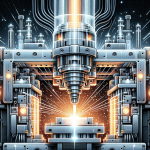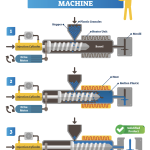Are you curious about how plastic injection molding is revolutionizing industries? This article delves into the nitty-gritty of this manufacturing marvel. From its fundamental processes to its far-reaching applications in sectors like automotive and healthcare, we've got you covered.
Key Takeaways
- Definition: A manufacturing process that involves injecting molten plastic into molds.
- Industries Served: Almost Every industry. Heavily used in automotive, healthcare, and consumer goods.
- Benefits: Cost-effective, highly customizable, and ideal for mass production.
The Fundamentals of Plastic Injection Molding
What is Plastic Injection Molding?
Plastic injection molding is a manufacturing technique where molten plastic is injected into pre-designed molds to produce parts or products.
Once the plastic cools and solidifies, the mold opens to eject the finished part. Simple as that.
How Does Injection Molding Work?
Injection molding typically consists of 6 steps. These steps are carried out with high efficiency in order to produce mass amounts of identical products or pieces.
- Material Selection: Choose the type of plastic material.
- Melting: Heat the plastic until it turns into a molten state.
- Clamping: Secure the mold halves together before the injection process.
- Injection: Inject the molten plastic into the mold.
- Cooling: Allow the plastic to cool and solidify.
- Ejection: Open the mold to remove the finished product.

Types of Plastics Used in Injection Molding
- Thermoplastics: These are plastics that can be melted and cooled multiple times without any significant degradation.
- Common examples include Polyethylene and PVC.
- Thermosetting Plastics: Once these plastics are set, they can't be remelted.
- Examples include Bakelite and Melamine.
Industries Benefiting from Plastic Injection Molding
Automotive
Plastic injection molding is indispensable in the automotive industry.
It's used to create a wide spectrum of parts like bumpers, dashboards, and even entire body panels.
Why?
Because it's fast, efficient, and can produce complex shapes that would be incredibly difficult with other methods.
Healthcare
Ever wondered how surgical instruments are so precise? Or how medical devices are so reliable?
Plastic injection molding plays a significant role here.
This intricate process facilitates the production of medical components that have to meet stringent quality and safety standards.
Consumer Goods
From the toothbrush you used this morning to the smartphone you're holding now, plastic injection molding is everywhere.
It's the reason you can buy high-quality goods without burning a hole in your pocket.
Advantages and Disadvantages
Cost-Effectiveness
One of the most compelling advantages of plastic injection molding is its cost-effectiveness.
When it comes to mass production, few methods can compete.
The initial setup cost might be high, but once the production line is rolling - the cost per unit drops dramatically.
Customization
Have a complex design in mind?
No problem.
Plastic injection molding is incredibly versatile, allowing for a high level of customization.
You can even use multiple types of plastics in the same process, thanks to techniques like over-molding and insert molding.
Customization Techniques
- Overmolding: Adding an additional layer of material over an existing part.
- Insert Molding: Integrating metal or another material into a plastic part during the molding process.
- Multi-shot Molding: Using multiple molds to produce parts with more than one material or color.
Environmental Impact
While plastic injection molding has many advantages, it's not without its challenges.
The use of plastic, a non-biodegradable material, raises environmental concerns.
However, many companies are adopting sustainable practices like using recycled or bio-based plastics.

Future Trends
Automation and AI
The future of plastic injection molding is bright.
Advancements in automation and artificial intelligence will undoubtedly push the bounds of what we deem achievable today.
These technologies are making the process faster, more accurate, and even more cost-effective.
Sustainability
As the world becomes more eco-conscious, the plastic injection molding industry is not far behind.
The focus is shifting towards sustainable materials and energy-efficient machines.
Sustainable Practices
- Using Recycled Plastics: Reduces waste and energy consumption.
- Energy-Efficient Machines: Lower electricity usage and carbon footprint.
- Biodegradable Plastics: Materials that break down naturally over time.
Conclusion
Plastic injection molding is a cornerstone in modern manufacturing.
Its versatility, efficiency, and cost-effectiveness make it indispensable across various industries.
As technology advances, this method is only expected to become more refined and eco-friendly.
If you are looking for top-notch quality and efficiency in an injection molding company - you're in the right place.
At JDI Plastics, we're not just about machines and molds - we're about making your vision come to life. So go ahead and give us a call today.
Let's turn those ideas into reality!



























